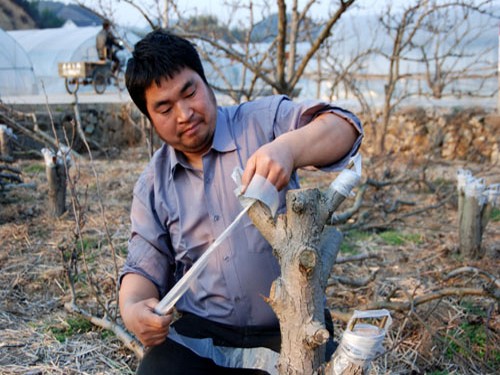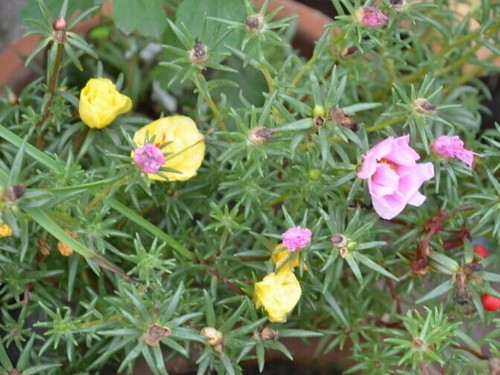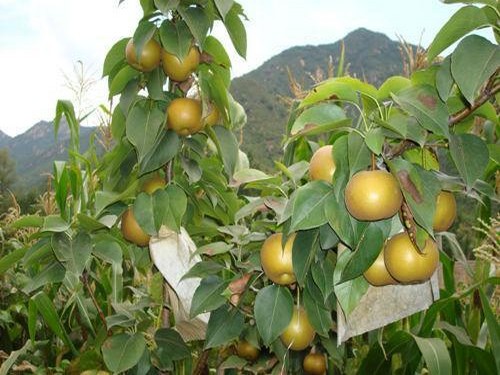Pear Grafting Technique
Pear tree is a traditional cultivated fruit tree in China. As early as 3000 years ago, working people have domesticated wild pear trees and selected many pear varieties. Pear trees not only have economic value, but also have important ecological value and ornamental value, and can also be widely used in urban and rural landscaping.

Pear leaves are colorful in terms of leaf shape, there are oval, oval, long oval, and petiole length is different. In terms of leaf color, pear leaves can be divided into spring leaves and autumn leaves, some varieties have tender leaves red and turn green after leaf expansion; some varieties turn bright yellow, reddish brown or purplish red in autumn, which is very ornamental.
Pear flowers are white and fragrant. Pears are corymbose, bisexual flowers, and their petals are suborbicular or broadly oval. In the spring season, pear blossoms are full of branches and wrapped in silver, and "Pear Blossom Festival" is held in many places during the flowering period of pear trees. Countless literati have written poems to pear blossom. Li Bai has "pear blossom white snow fragrance", du Mu has "pear blossom sends spring alone", Su Shi has "pear blossom light white willow deep green", Lu you has "Yilu pear blossom everywhere" and so on.
Pear fruit plump sweet pear fruit shape is round, flat round, oval, ladyshaped, fruit color has yellow, green, brown, red and staggered variation and so on. Yali pear widely cultivated in North China has a pointed oval fruit shaped like a duck head and a golden pericarp.-Korla fragrant pear, with yellow-green fruit color, bright and beautiful on the sunny side, is a precious variety in the northwest region. The aroma of pear fruit is strong, fragrant, slightly fragrant, fragrant and so on.
For the reproduction of pear trees, Qiuzi pear, Shanli pear, du pear and pear pear can be selected as rootstocks. Pear varieties with strong growth, good quality and easy to hang fruit are used as scions and grafted by bud grafting or branch grafting. The rootstock can not only be propagated artificially, but also use the old pear trees eliminated in the orchard or the old stakes of the pear varieties such as short, peculiar shape, early branching, simple and vigorous mountain pear, which can be rejuvenated by "raising billet". Make it grow new branches, and then graft. The stump is generally excavated and transplanted after falling leaves in autumn or before germination in spring, first planted in the ground or in a larger tile basin, reshape the plant before planting, cut off the overlong main root, retain the lateral root and whisker root, and cut off the excess branches. After planting, pour water thoroughly and keep it in a place away from the wind and the sun to ensure survival.
Pear grafting mainly refers to bud grafting from July to August. One is the grafting of pear nursery seedlings and rootstocks after the establishment of the garden. The second is the grafting when updating the variety. In other words, when the inferior varieties with good branching ability are renewed in the annual pear orchard, the high bud grafting method is used to change the head.
1. Preparation before budding
The main results are as follows: (1) determination of grafting combination. Before grafting begins, the grafting combination should be determined and the seedling production plan should be determined according to the local fruit tree development plan. In other words, it is necessary to determine what varieties to cultivate, where the seedlings will be sold and planted, and what rootstocks to use.
(2) selection, storage, transportation and inspection of scions. After the variety is determined, the scion should be cut on the female parent tree with pure variety, high yield, stable yield, high quality and no testing object. The branches selected as scions have good light on the outside of the crown, and the developed branches with full growth are the best.
Grafting in summer and autumn often uses the new shoots of the same year as scions.
The scion adopted during the growing period had better be used with picking. After picking the branches, the leaves should be cut off immediately to reduce water evaporation, and the petiole should be cut to 1 cm long so that the bud grafting can be operated and checked to survive. The scion should be kept in a cool place. The lower end of the scion should be cultivated with wet sand, and pay attention to spray water to moisturize. The scion taken during the dormant period is generally stored in the cellar or buried in wet sand.
When the scion needs to be shipped out, the variety label should be attached, wrapped in moisturizing packaging material and packed in wooden cases or bamboo baskets. Open the bag immediately after arrival and bury the scion in a cool place with wet sand for use.
Check the scion during the growth period, usually to see whether the skin shrinks or changes color, and whether it is easy to peel off when budding. If the scion has been wrinkled, soak in water until it absorbs enough water; the discolored scion can not be used; the scion that does not leave the skin can be grafted by embedded bud grafting.
(3) preparation of rootstocks. Before grafting, a comprehensive inspection of rootstock seedlings should be made. To master the growth status, thickness, diseases and insect pests of rootstock seedlings. For the rootstock seedlings used for bud grafting, the lower branches should be cut off before grafting, and an insecticide should be used to facilitate operation. when there are many weeds in the nursery, they should also be hoed once; if the weather is dry, they should be irrigated once three or four days before grafting to facilitate peeling and healing. When there are more than two grafted varieties, the nursery area should be divided according to the number of each variety, a sign should be inserted to show the difference, and a schematic diagram of the division should be drawn and checked once.
2. The best period of grafting
The success or failure of grafting is closely related to the temperature and the activity of rootstock cambium. According to the study, the proliferation of healing tissue of pear increased with the increase of temperature in the range of 5 ℃ ~ 32 ℃, but outside this temperature range, the proliferation of healing tissue was very slow when the temperature was too low or too high. Because the healing tissue needs certain nutrients, the higher the Lignification degree of rootstock and scion is, the more nutrients are stored, and it is easier for grafting to survive under certain temperature and humidity conditions.
3. Bud
The grafting of a bud piece as a scion with the branches of a rootstock is called bud grafting. The method of bud grafting is simple, easy to master, save scion, high efficiency, good healing and fast seedling formation. The common bud grafting methods for pear grafting propagation are as follows:
(1) T-shaped bud grafting. T-shaped bud grafting is generally used for 1 ~ 2-year-old rootstock seedlings, the rootstock is too large, the bark thickens, and the grafting is not easy to survive. When grafting, first cut the bud, hold the scion with petiole in the left hand, hold the bud knife in the right hand, put the knife 0.7-1cm below the petiole, hold the back of the knife with the thumb of the left hand, take wood oblique cutting forward, to 0, 5 cm, 7 cm above the bud, cross-cut half a circle at the left and right of 0, 5 cm above the bud, reach to the xylem, then hold the bud with your hand, and take off the bud as soon as you break it. In the rootstock seedling about 20cm from the ground, smooth non-branching place cut a "T" shape, deep to the xylem (do not cut too deep, causing the bud to germinate in the same year). The width of the transverse cut is about 1 cm and the vertical incision is about 2 cm. Insert the bud into the "T" shaped wound. When inserting buds, pick out the interface with the handle of the bud, insert the bud piece gently from top to bottom, align the top of the bud with the "T" transverse incision, close it, and then bind it from top to bottom with plastic sheeting strips, bind it tightly, and expose the bud and petiole, and wrap the bud tightly.
(2) embedded bud grafting. The method of embedded bud grafting is mostly used for grafting when the rootstock is not without skin in spring and autumn. In summer bud grafting, if the scion is not good or not without skin, it can also be used for grafting. First, in the abdomen of the 20 cm 30 cm internodes of the rootstock, cut obliquely with a bud splice knife, about 2 cm long, slightly above the bottom of the first knife of the rootstock, cut the second knife at 30 °to the bottom of the first knife, take off the buds, prepare the rootstock incision, and when cutting the buds, first cut downwards at about 1 cm above the scion, about 2 cm long, and then cut the second knife at 30 °at about 0 cm, 7 cm and 8 cm below the bud. Until the bottom of the first knife, remove the grafted piece with wood, and finally insert the grafted piece into the cut of the rootstock and bind it.
(3) ring bud grafting. When pear rootstock seedlings are small, early budding in summer, but it is inconvenient to use T-shaped budding, ring budding can be used. First cut around the rootstock for two weeks, the distance between the two weeks is about 2cm or 5cm, reaching to the xylem, then cut longitudinally between two weeks, and then peel off all the skin of this part of the rootstock (if the rootstock is thicker than the scion, you can cut twice in the rootstock in two weeks, leaving a skin). After the rootstock is cut, take a bud piece of the same width on the scion so that the bud resides in the middle. Immediately put the bud piece into the incision and bind it.
In the actual production, different budding methods can be selected according to different conditions. However, due to the higher technical requirements of embedded bud grafting and ring bud grafting, T-shaped bud grafting is often used when there is no special case.
In the pear orchard, the high bud grafting method was used to change the head, and the T-shaped bud grafting method was also used to graft a bud piece of an excellent variety at the base of each branch, and then tightly bound with plastic sheet. If the original branches grow vigorously, they can be grafted in the first and middle of July and cut the rootstock in the same year after survival to promote bud germination and branching. Otherwise, when the new shoot of the original tree grows weakly, the grafting time should be postponed and the rootstock should be cut before sprouting in the next spring.
4. Binding and moisturizing of grafting
At present, plastic strips are often used as binding materials in production, and substitutes such as Iris can also be used. The width and length of the cutting plastic cloth strip can be determined according to the thickness of the rootstock used for budding. Bind the buds or scions tightly with plastic sheeting strips from top to bottom, expose the buds and petioles or wrap them completely. In recent years, after two years of experiments in Datai Mountain Fruit Tree Farm in Liaoning Province, a new method of T-shaped bud binding has been put forward. This method is simpler and labor-saving than using plastic strips, does not need to be unbound, and the survival rate is more than 90%. The specific method: using a self-made simple fork press to press the iron wire (No. 24) into a 1 × 2 cm "U" shaped fork, and using a cutter to cut the latex film into small squares of 2, 5 × 2, 5 cm. Then insert each fork into one end of a piece of film and place it in a small box. When the grafting bud is inserted into the wound of the rootstock, hold the film with a fork in one hand and the other end in the other, wrap the bud tightly in the film, and then fasten the film with a fork. Due to the rapid aging of the film in the sun, it began to crack after the budding survived, and finally it cracked naturally until it fell off without unbinding.
Time: 2019-05-25 Click:
- Prev

Planting technique of Scutellaria barbata
Scutellaria barbata is a kind of Labiatae plant, its dry aboveground part has the functions of heat-clearing and detoxification, promoting blood circulation and removing blood stasis, reducing swelling and pain, anti-cancer and so on. Jiang Yi's "picking up the remains of Medicine Mirror" records half a lotus to cure the fairy grass injured by snakes. In addition to the treatment of venomous snake bites, it is also used to treat tumors, which has a certain short-term effect.
- Next

Planting and Management techniques of Pear trees
In order to highlight its individual beauty, pear trees can be planted alone in the greening of the park. Generally choose open and open places, such as the edge of the lawn, the center of the flower bed, the sunny corner and both sides of the door, and so on. In spring, snow-white pear blossoms bloom; in autumn, rich pear fruit is covered with branches, making a beautiful scenery in the park.
Related
- Fuxing push coffee new agricultural production and marketing class: lack of small-scale processing plants
- Jujube rice field leisure farm deep ploughing Yilan for five years to create a space for organic food and play
- Nongyu Farm-A trial of organic papaya for brave women with advanced technology
- Four points for attention in the prevention and control of diseases and insect pests of edible fungi
- How to add nutrient solution to Edible Fungi
- Is there any good way to control edible fungus mites?
- Open Inoculation Technology of Edible Fungi
- Is there any clever way to use fertilizer for edible fungus in winter?
- What agents are used to kill the pathogens of edible fungi in the mushroom shed?
- Rapid drying of Edible Fungi

